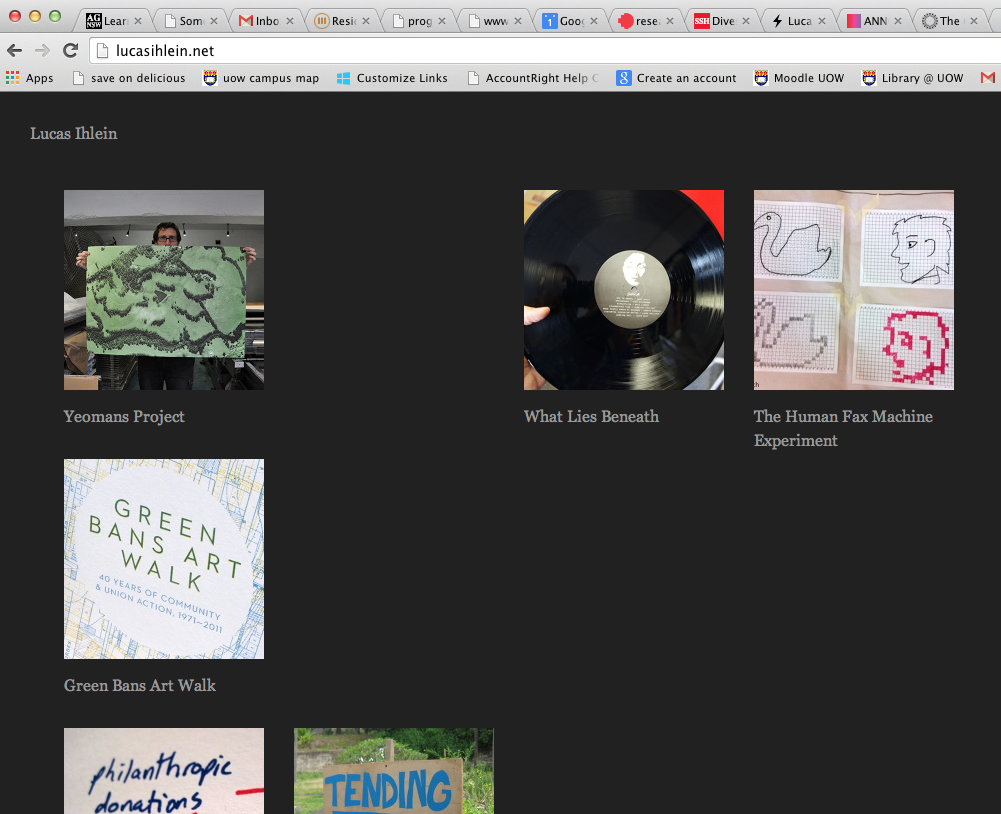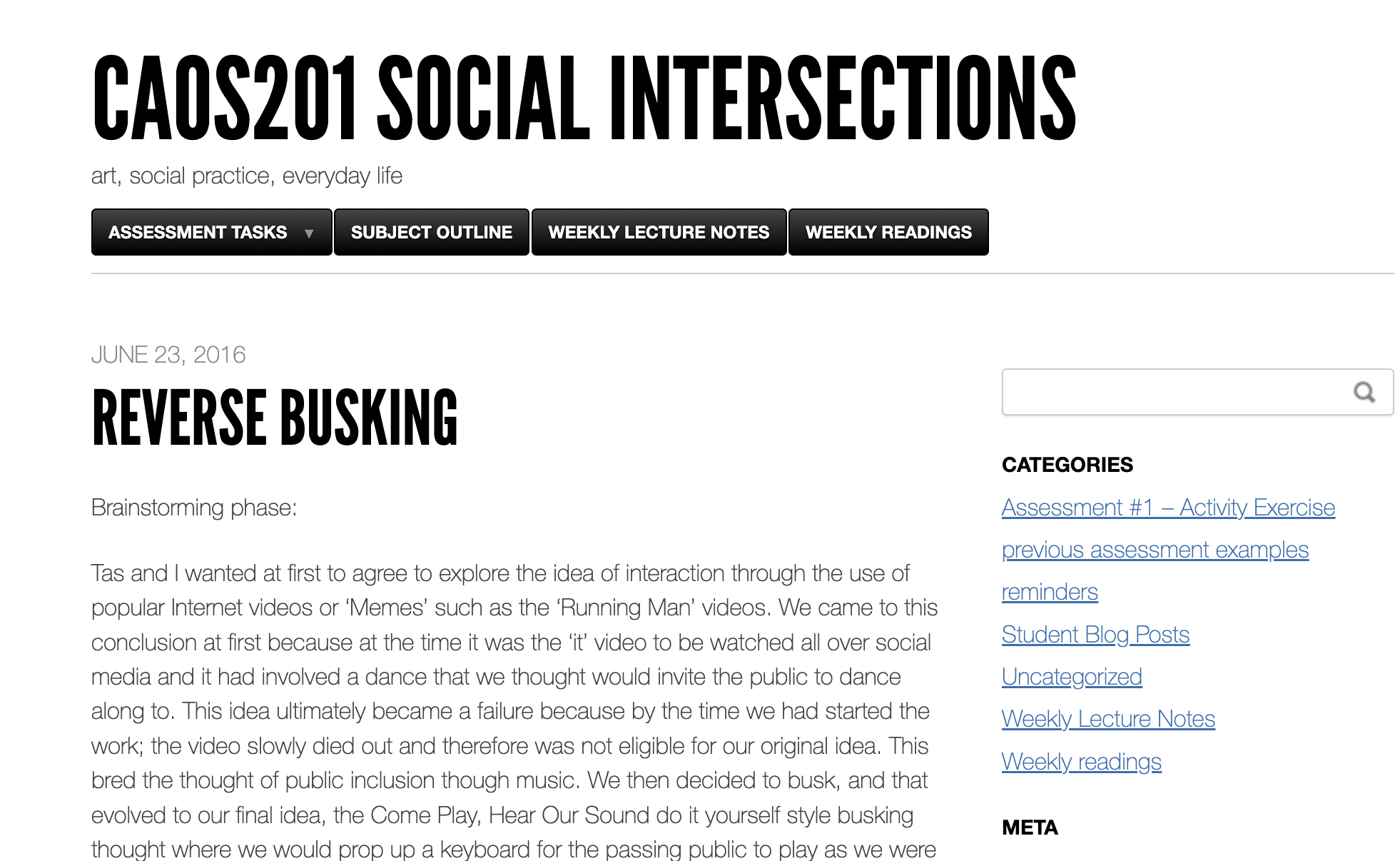Precursors:
I’ve been working on re-enactments in one way or another since about 1996, when I did a performance work called Cornflakes in Perth. It was, in some way, about the daily re-enactment of getting out of bed and eating breakfast.
Another early work, The Peg#24 Pieces (1996), in collaboration with Mick Hender, explored the relationship between performative action and score.
Fluxus and Happenings:
In 2002, I conducted (sort of in the way a conductor conducts an orchestra) a re-enactment of Albert M Fine’s Fluxorchestra for 24 Performers. It was part of a project called Bilateral, where I lived in the gallery of the Experimental Art Foundation in Adelaide for the duration of the exhibition.
The Fluxorchestra was a classic Fluxus event which had a wonderful series of scores (one for each participant) that could be followed, and drew in many members of the local arts community for a celebration of the absurd. I’d very much like to do it again sometime.
In 2009, I worked with Nick Keys and Astrid L’Orange to re-enact Allan Kaprow’s Push and Pull – a Furniture Comedy for Hans Hoffman – a happening/environment from 1963. This was part of There Goes the Neighbourhood, at Performance Space.
Our version of Push and Pull was documented heavily as a blog.
The great thing about this was that the documentation from our re-enactment goes back to the Allan Kaprow estate, where it becomes part of the ongoing narrative about this work.
Expanded Cinema:
Via Fluxus, I became fascinated with Expanded Cinema, which is a performative branch of experimental film culture from the 1960s. There are significant crossovers between Fluxus, performance art and Expanded Cinema – VALIE EXPORT and Carolee Scheeman being two examples.
Working collaboratively with SMIC (Sydney Moving Image Coalition), and in particular with Louise Curham, I embarked on a series of experiments with re-enacting key works of Expanded Cinema from the past. These early attempts (2003-5) were pretty rough but they set us on our path. Our later works were very research intensive.
Here’s some info about our re-enactment work with SMIC (which we later renamed Teaching and Learning Cinema).
Our two most significant Expanded Cinema re-enactments to date are:
Anthony McCall’s Long Film for Ambient Light (1975) (re-enacted in 2007)(about which I wrote a chapter for Amelia Jones and Adrian Heathfield’s book Perform Repeat Record.
and
Guy Sherwin’s Man with Mirror (1976) (re-enacted in 2009-onwards).
In May 2013, Louise Curham and I went to London to begin work with Malcolm Le Grice on re-enacting a work of his from 1971, Horror Film 1. This re-enactment will continue to be developed during 2014.
This is a fairly clear description of our general work with re-enacting Expanded Cinema.
Daily life in a Cagean frame:
My 2005-6 twin projects, Bilateral Kellerberrin and Bilateral Petersham, were for me an “evolved re-enactment” of John Cage’s 4’33”. In the methodology underlying these projects, I took Cage’s 4’33” as a format or template, and shifted it to my own time and place. While Cage’s piece tends to be performed in a concert hall, and lasts only four minutes and thirty three seconds, my projects took his template into a neighbourhood social sphere, extended the duration to 2 months of my own daily life, and registered the chance occurrences through blogging. (To be clear: at the time, this Cagean connection was not foregrounded publically as the reason for the work’s existence, but was rather an unspoken skeleton shaping my daily practice).
Intergenerational Revisitations:
In 2011, I began working with Ian Milliss, a veteran Aussie conceptual artist, on a re-enactment of his Yeomans Project from 1975-6. It is in some ways more of an enactment, in that the original work never came to pass back in the 1970s. This intergenerational contact (Milliss, as well as Guy Sherwin, Anthony McCall, etc) is an ongoing part of my practice.
Discussions around re-enactment and performance:
In 2012, I convened a panel discussion with Christopher Hewitt and Andrea Saemann, on re-enacting performance art at University of Wollongong. It was part of a symposium called Expanded Documentary.

